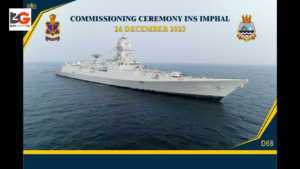Joining the Indian Navy on December 26, 2023, is the third stealth-guided missile destroyer of the Visakhapatnam class, INS Imphal (Pennant D68). This class exemplifies cutting-edge indigenous destroyer technology and is a component of Project 15B.

INS
Transforming the Kolkata Class into the Visakhapatnam Class
The Indian Navy upgraded from the Delhi-class to the Kolkata-class guided missile destroyers, which were commissioned between 2014 and 2016.
In the Kolkata class were INS Kochi, INS Chennai, and INS Kolkata. Then, Mazagon Dock Shipbuilders Limited (MDSL) was in charge of building the Visakhapatnam class, which came out as a more advanced version under Project 15B.
The Schedule and List of Ships for Project 15B
In January 2011, the contract for Project 15B was signed. The lead ship, INS Visakhapatnam (D66), was commissioned in November 2021. In December 2022, INS Mormugao (D67) was commissioned.
The third ship is INS Imphal (D68), and the fourth is expected to be INS Surat (D69). The four main cities that these ships are named for are Surat, Imphal, Visakhapatnam, and Mormugao.
Significance of INS Imphal’s Construction Milestones
Yard 12706 was dubbed as INS Imphal during the keel laying ceremony that took place on May 17, 2017, marking the beginning of construction.
Launched into the water on April 20, 2019, the ship successfully completed sea trials and was delivered on October 20, 2019. The official arrival into active service is signified by the commissioning on December 26.
Armament and Technological Features
With a length of 163 meters and a width of 17.4 meters, the destroyers of the Visakhapatnam class can carry a payload of 7,400 tonnes.
They have a ‘combined gas and gas’ (COGAG) design with four gas turbines that allows them to reach speeds of up to 30 knots and a range of up to 4,000 nautical miles.
These ships, manned by a crew of about 350, have an emphasis on being very habitable and having excellent ergonomics.
The class is equipped with a total atmosphere control system (TACS) that protects against chemical, biological, and nuclear threats, as well as multiple fire zones and advanced battle damage control systems.
These destroyers are able to efficiently evaluate dangers and distribute resources because of their cutting-edge battle management system.










